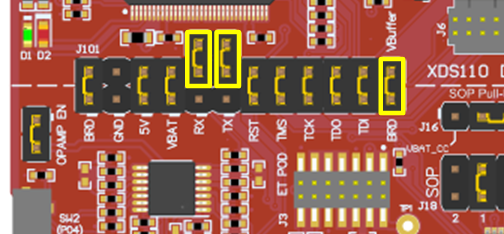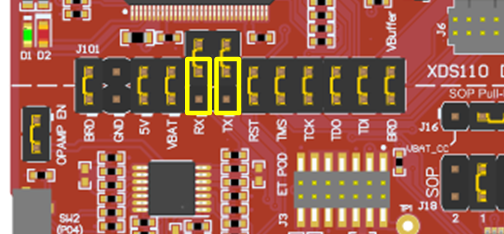SWRU548C February 2019 – September 2021 CC3235MODAS , CC3235MODASF , CC3235MODS , CC3235MODSF
- 1Introduction
-
2Hardware
- 2.1 Block Diagram
- 2.2
Hardware Features
- 2.2.1 Key Benefits
- 2.2.2 XDS110-Based Onboard Debug Probe
- 2.2.3 Debug Probe Connection: Isolation Jumper Block
- 2.2.4 Application (or "Backchannel") UART
- 2.2.5 JTAG Headers
- 2.2.6 Using the XDS110 Debug Probe with a Different Target
- 2.2.7 Power Connections
- 2.2.8 Reset Pullup Jumper
- 2.2.9 Clocking
- 2.2.10 I2C Connection
- 2.2.11 Sense on Power (SOP)
- 2.2.12 Push-Buttons and LED Indicators
- 2.3 Electrical Characteristics
- 2.4 Antenna Characteristics
- 2.5 BoosterPack Plug-in Module Pinout
- 3Layout Guidelines
- 4Operational Setup and Testing
- 5Development Environment Requirements
- 6Additional Resources
- 7Assembly Drawing and Schematics
2.2.4 Application (or "Backchannel") UART
The board supports a USB-based virtual COM port, using the SimpeLink™ MSP432E401Y Arm® MCU. The LaunchPad is shipped with the UART lines from the CC3235MODSF connected to the UART on the MSP432E4 MCU. The CC3235MODSF's UART can also be routed to the 20-pin connector for use as a GPIO or external UART. The selection is performed using jumpers on the board.
Figure 2-5 shows the UART routed to USB COM port. Ensure that a jumper is also placed on the VBUFFER header to power the level shifters located on the emulator side of the board. Figure 2-6 shows the UART routed to 20-pin header connector.
 Figure 2-5 UART Routed to USB COM Port
Figure 2-5 UART Routed to USB COM Port Figure 2-6 UART Routed to 20-Pin Header Connector
Figure 2-6 UART Routed to 20-Pin Header Connector